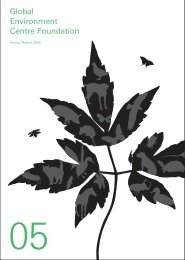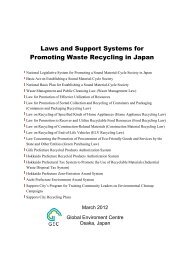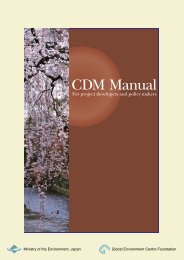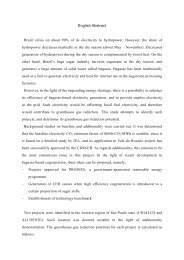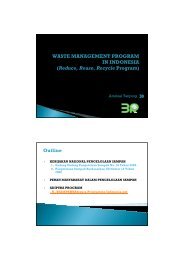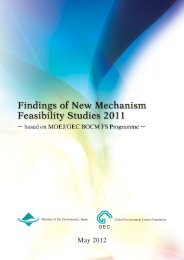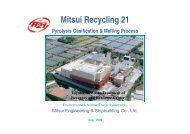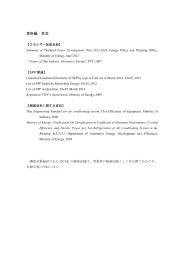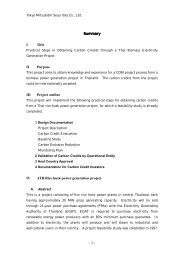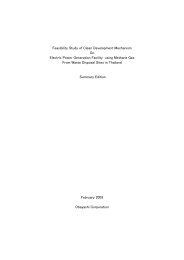Reforestation/Afforestation and Biomass Energy Projects in 3 ...
Reforestation/Afforestation and Biomass Energy Projects in 3 ...
Reforestation/Afforestation and Biomass Energy Projects in 3 ...
You also want an ePaper? Increase the reach of your titles
YUMPU automatically turns print PDFs into web optimized ePapers that Google loves.
REPORT SUMMARY<br />
CDM/JI FEASIBILITY STUDIES 2003<br />
A/R AND BIOMASS ENERGY PROJECTS IN INDONESIA<br />
March 2004<br />
Sumitomo Forestry Co., Ltd.<br />
Sumitomo Forestry Co., Ltd reported two projects for biomass energy <strong>and</strong> three projects for<br />
afforestation <strong>and</strong>/or reforestation activities. Details are available <strong>in</strong> our experimental PDD <strong>in</strong> English on<br />
the web. site of Global Environment Centre Foundation.<br />
Part 1 <strong>Biomass</strong> <strong>Energy</strong> <strong>Projects</strong><br />
1 RPI CDM <strong>Biomass</strong> Project <strong>in</strong> Central Java<br />
The RPI project is carried out by PT Rimba Partikel Indonesia ( PT RPI ). PT.RPI manufactures<br />
particle board, a type of wooden board used for furniture <strong>and</strong> hous<strong>in</strong>g. PT.RPI is located <strong>in</strong> the<br />
Central Java prov<strong>in</strong>ce <strong>in</strong> the Republic of Indonesia. Production has been around 100,000 –<br />
120,000 metric ton a year. The company uses wood wastes for their raw materials, which are<br />
collected from <strong>in</strong>dustries, local community <strong>and</strong> their own forest plantation activity.<br />
The RPI project is composed of components as follows;<br />
A) “Substitution of the fossil fuel by <strong>in</strong>stallation of biomass fuel facilities <strong>in</strong>to manufactur<strong>in</strong>g<br />
process”<br />
- <strong>Biomass</strong> fuel chip dryer component<br />
The wood powder as biomass fuel will be used as substitute for diesel oil. A biomass fuel chip<br />
dryer will largely reduce the current use of diesel oil. This will result <strong>in</strong> a reduction of carbon<br />
dioxide emissions from combustion of diesel oil, because CO2 emitted from biomass is def<strong>in</strong>ed<br />
as carbon-neutral under IPCC guidel<strong>in</strong>es. This component was <strong>in</strong>stalled <strong>in</strong> 2002 <strong>and</strong> has been<br />
work<strong>in</strong>g.<br />
- <strong>Biomass</strong> fuel power plant component<br />
A biomass fuel power plant will be <strong>in</strong>stalled <strong>in</strong>to a factory as substitute for a diesel oil power<br />
plant. This displacement will largely elim<strong>in</strong>ate carbon dioxide emissions from the current<br />
practice of us<strong>in</strong>g the diesel oil power plant because of same reason as above.<br />
B) “Supply of electricity to power grid by biomass fuel generation”<br />
- Electricity supply component<br />
The sale of surplus electricity generated by the biomass fuel power plant will substitute for<br />
grid electricity <strong>and</strong> result <strong>in</strong> reduction of carbon dioxide emissions from combustion of fossil<br />
fuel for electric generation on the power grid, because CO2 emitted from biomass is def<strong>in</strong>ed<br />
as carbon-neutral under IPCC guidel<strong>in</strong>es.<br />
Project participants are PT Rimba Partikel Indonesia, Semarang, Central Java Prov<strong>in</strong>ce, the<br />
Republic of Indonesia <strong>and</strong> Sumitomo Forestry Co., Ltd. Tokyo, Japan.<br />
Category(ies) of project activity: There are two categories as for the project activities;<br />
- <strong>Energy</strong> <strong>in</strong>dustries (Renewable energy):Grid-connected electricity generation<br />
- Manufactur<strong>in</strong>g <strong>in</strong>dustries : substitution of the fossil fuel
The Basel<strong>in</strong>e Methodology of the Project is;<br />
Name Compornent Objectives <strong>and</strong> details Basel<strong>in</strong>e Scenario<br />
Substitution of<br />
the fossil fuel by<br />
<strong>in</strong>stallation of<br />
biomass fuel<br />
facilities <strong>in</strong>to<br />
manufactur<strong>in</strong>g<br />
process<br />
Supply of<br />
electricity to<br />
power grid by<br />
biomass fuel<br />
generation<br />
<strong>Biomass</strong>-typed<br />
wood chip drier<br />
component<br />
<strong>Biomass</strong> fuel<br />
power plant<br />
component<br />
Electricity<br />
supply<br />
component<br />
The wood powder as biomass<br />
fuel will be used as<br />
substitute for diesel oil. A<br />
biomass-typed wood chip<br />
drier will largely reduce the<br />
current use of diesel oil. This<br />
will result <strong>in</strong> a reduction of<br />
carbon dioxide emissions<br />
from combustion of diesel oil.<br />
Therefore, the basel<strong>in</strong>e of<br />
this component is decided to<br />
be the emission from the<br />
current use of the biomass<br />
fuel chip dryer.<br />
A biomass fuel power plant<br />
will be <strong>in</strong>stalled <strong>in</strong>to a<br />
factory as substitute for a<br />
diesel oil power plant. This<br />
displacement will largely<br />
elim<strong>in</strong>ate carbon dioxide<br />
emissions from the current<br />
practice of us<strong>in</strong>g the diesel<br />
oil power plant. Therefore,<br />
the basel<strong>in</strong>e of this<br />
component is decided to be<br />
the emissions from current<br />
use of the diesel oil power<br />
plant.<br />
The sale of surplus<br />
electricity generated by the<br />
biomass fuel power plant will<br />
substitute for grid electricity<br />
<strong>and</strong> result <strong>in</strong> reduction of<br />
carbon dioxide emissions<br />
from combustion of fossil fuel<br />
for electric generation on the<br />
power grid.<br />
Basel<strong>in</strong>e scenario related to<br />
the biomass fuel facilities is<br />
that the exist<strong>in</strong>g diesel oil<br />
facilities will not be retooled<br />
<strong>and</strong> will be cont<strong>in</strong>ued to be<br />
used <strong>in</strong> manufactur<strong>in</strong>g<br />
process dur<strong>in</strong>g a credit<strong>in</strong>g<br />
period (2003-2012).<br />
Determ<strong>in</strong>e fossil fuel<br />
consumption as basel<strong>in</strong>e by<br />
consideration of energy<br />
efficiency Calculate CO2<br />
emission from diesel oil<br />
consumption<br />
Same as above.<br />
With regard to the basel<strong>in</strong>e<br />
scenario, the biomass fuel<br />
power plant would not be<br />
<strong>in</strong>stalled <strong>and</strong> the exist<strong>in</strong>g<br />
diesel oil power plant will<br />
cont<strong>in</strong>ue to be used for the<br />
generation of electricity <strong>in</strong><br />
the factory.<br />
Monitor<strong>in</strong>g methodologies are;<br />
Methodology<br />
General description<br />
Monitor<strong>in</strong>g methodology I aims to monitor the fact that proposed fossil fuel has<br />
methodology I been partially reduced or totally elim<strong>in</strong>ated ow<strong>in</strong>g to two components <strong>in</strong><br />
question. It requires to be monitored by direct measurement<br />
Monitor<strong>in</strong>g methodology II <strong>in</strong>tends to monitor the fact that power generation is<br />
totally replaced by biomass materials as well as its progress compared to its<br />
methodology II<br />
orig<strong>in</strong>al design<strong>in</strong>g. All the monitor<strong>in</strong>g items are also available by direct<br />
measurement.<br />
Emission reduction by the Project is estimated to be 212,528 CO2-ton as follows;<br />
2
year 2003 2004 2005 2006 2007 2008 2009 2010 2011 2012 Total<br />
Basel<strong>in</strong>e 21,057 22,617 22,498 23,020 22,901 22,784 22,668 22,555 22,443 22,332 224,875<br />
Methodology I Emission 15,373 16,451 16,623 2,569 2,595 2,595 2,595 2,595 2,595 2,595 66,584<br />
Reduction 5,684 6,166 5,875 20,451 20,306 20,189 20,073 19,960 19,848 19,737 158,291<br />
Basel<strong>in</strong>e 0 0 0 7,626 7,733 7,626 7,733 7,733 7,839 7,945 54,237<br />
Methodoolgy II Emission 0 0 0 0 0 0 0 0 0 0 0<br />
Reduction 0 0 0 7,626 7,733 7,626 7,733 7,733 7,839 7,945 54,237<br />
Total reduction 5,684 6,166 5,875 28,077 28,039 27,815 27,806 27,693 27,687 27,682 212,528<br />
Environmental impacts <strong>and</strong> social impacts by the project are considered as follows;<br />
Environmental impacts should be considered before the project commences. If there is significant<br />
<strong>and</strong> negative impacts, the project participants should implement environmental impact<br />
assessment based on the host country’s regulation, which is called AMDAL <strong>in</strong> Indonesia <strong>and</strong> well<br />
established system under BAPEDAL facilitated under the M<strong>in</strong>istry of Environment. If the project<br />
is small <strong>and</strong> no negative impacts, the participants should voluntarily make a environmental<br />
management <strong>and</strong> monitor<strong>in</strong>g plan before start<strong>in</strong>g.<br />
Cost effectiveness of the project is expected to be US$19,646,000/212,528 = US$92.4 /CO2-ton<br />
From the above estimation, it is clear that there is no <strong>in</strong>centive to <strong>in</strong>vest to the proposed project<br />
without CDM activity, because the long term cost of <strong>in</strong>stallation of the project is higher than that<br />
of the basel<strong>in</strong>e scenario. In addition, the <strong>in</strong>centive to <strong>in</strong>vest may lag because of a high risk of<br />
implementation of the project.<br />
2. KTI <strong>Biomass</strong> Project <strong>in</strong> East Java<br />
The project will reduce anthropogenic GHG emissions by displac<strong>in</strong>g electricity generated by<br />
electric power plant with electricity generated by biomass energy. This project is carried out by<br />
PT Kutai Timber Indonesia (PT KTI) which products wood products such as plywood, timber <strong>and</strong><br />
woodworks, <strong>in</strong> the East Java Prov<strong>in</strong>ce. For the purpose of substitution of electricity supplied from<br />
electrical grid through biomass energy utilization. For the purpose of substitution of<br />
grid-connected electricity, PT KTI facilitate their biomass generators with 10MW capacity.<br />
The CDM project will create CER which is equivalent to the reduced grid-connected electricity as<br />
an energy substitution project. As for electricity power supply project, PT KTI will sell their<br />
surplus electricity to national power grid. The emission reductions are equivalent to the sold <strong>and</strong><br />
substituted electricity which is calculated based on average grid emission will becomes CER as a<br />
CDM project.<br />
There are two categories as for the project activities;<br />
- <strong>Energy</strong> <strong>in</strong>dustries (Renewable energy): Grid-connected electricity generation<br />
- Manufactur<strong>in</strong>g <strong>in</strong>dustries : Substitution of grid electricity with biomass energy<br />
This project consists of two components. The methodology described approach (a) is selected to<br />
determ<strong>in</strong>e the basel<strong>in</strong>e of each component.<br />
Basel<strong>in</strong>e methodologies of the project are;<br />
Methodology I<br />
Substitution of grid-connected<br />
Name<br />
electricity by biomass fuel generator<br />
A biomass fuel power plant will be<br />
<strong>in</strong>stalled <strong>in</strong>to a factory as substitution<br />
for a electricity used <strong>in</strong> the factory.<br />
Approach<br />
The electricity is supplied via<br />
electrical grid. This displacement will<br />
largely elim<strong>in</strong>ate carbon dioxide<br />
Methodology II<br />
Supply of electricity to power grid by<br />
biomass fuel generation<br />
The sale of excessive electricity generated<br />
by the biomass fuel power plant will<br />
substitute for grid electricity <strong>and</strong> result <strong>in</strong><br />
reduction of carbon dioxide emissions<br />
from combustion of fossil fuel for electric<br />
generation on the power grid because<br />
3
Scenario<br />
Project<br />
period<br />
Boundary<br />
Additionality<br />
emissions from the generation on<br />
national electrical grid. The generation<br />
on the national grid was ma<strong>in</strong>ly<br />
conducted by fossil fuel combustion <strong>in</strong><br />
Indonesia.<br />
Basel<strong>in</strong>e scenario is that electricity<br />
supplied from power grid will cont<strong>in</strong>ue<br />
to be used <strong>in</strong> the factory dur<strong>in</strong>g a<br />
credit<strong>in</strong>g period (2006-2015).<br />
CO2 emitted from biomass is def<strong>in</strong>ed as<br />
carbon-neutral under IPCC guidel<strong>in</strong>es.<br />
Basel<strong>in</strong>e scenario is that electricity<br />
supplied from power grid will cont<strong>in</strong>ue to<br />
be used <strong>in</strong> the factory dur<strong>in</strong>g a credit<strong>in</strong>g<br />
period (2006-2015).<br />
10 years (2006-2015). 10 years (2006-2015).<br />
The project boundary of the project is<br />
all the factory site.<br />
(1)Technological barriers; Assessment<br />
of economically attractive courses of<br />
action<br />
(2)Barrier of common conscious<br />
(3)Technology is considered from<br />
assessment of common conscious <strong>and</strong><br />
policies <strong>in</strong> the project area<br />
The project boundary of the project is all<br />
the factory site.<br />
(1)Technological barriers; Assessment of<br />
economically attractive courses of action<br />
(2)Barrier of common conscious<br />
(3)Technology is considered from<br />
assessment of common conscious <strong>and</strong><br />
policies <strong>in</strong> the project area<br />
Emission reduction by the project is;<br />
Table E.5.1. Total emission reduction by the project Unit:(tonCO2)<br />
2006 2007 2008 2009 2010 2011 2012 2013 2014 2015 Total<br />
Basel<strong>in</strong>e 44,882 45,026 44,935 45,309 45,149 45,874 46,521 47,206 47,890 48,572 461,363<br />
Emission 2,269 2,708 2,599 2,609 2,515 2,424 2,441 2,404 2,471 2,533 24,973<br />
Reduction 42,613 42,318 42,335 42,699 42,634 43,450 44,080 44,802 45,419 46,039 436,390<br />
Part 2 <strong>Afforestation</strong> <strong>and</strong>/or <strong>Reforestation</strong> Project<br />
1. KTI A/R CDM Project <strong>in</strong> East Java<br />
The project is developed by PT. Kutai Timber Indonesia ( refereed as “ PT KTI” here<strong>in</strong>after ), who<br />
is plywood manufactures <strong>in</strong> Indonesia established <strong>in</strong> 1975 with the head office <strong>in</strong> Jakarta <strong>and</strong><br />
factory <strong>in</strong> Probol<strong>in</strong>ggo, East Java prov<strong>in</strong>ce. The company raises necessary substance to commence<br />
the project <strong>and</strong> will manage it together with stakeholders.<br />
General description of the project is;<br />
Items<br />
Description<br />
Title of the project A/R CDM project <strong>in</strong> East Java Provice<br />
activity<br />
Category<br />
LULUCF<br />
Type<br />
A/R activities<br />
4
Purpose of the<br />
project Activity<br />
Site, areas <strong>and</strong><br />
boundary<br />
Project period<br />
Participants<br />
Tree species<br />
1) To <strong>in</strong>crease carbon stock by plant<strong>in</strong>g trees <strong>in</strong> community l<strong>and</strong> through<br />
falcata-based agroforestry system <strong>and</strong> <strong>in</strong> state l<strong>and</strong> through <strong>in</strong>dustrial<br />
timber plantation.<br />
2) To reduce pressure on natural forest to meet dem<strong>and</strong> for future raw<br />
material of timber for plywood <strong>in</strong>dustry<br />
3) To <strong>in</strong>crease soil productivity <strong>and</strong> reduce soil degradation at steep slopes<br />
surround<strong>in</strong>g the project area.<br />
4) To improve <strong>in</strong>come of local communities<br />
Project sites are scattered <strong>in</strong> the prov<strong>in</strong>ce <strong>and</strong> <strong>in</strong>tegrated as s<strong>in</strong>gle project<br />
boundary<br />
Site Area Method<br />
Pasuruan 500ha Agro-forestry<br />
Krucil 500ha Industrial plantation<br />
Jember 1,000ha Industrial plantation<br />
Others* 500ha Agro-forestry <strong>in</strong><br />
approx. 10 sites<br />
Total<br />
2,500ha<br />
* Ngantang, UNIBRAW, UNESA, Probol<strong>in</strong>ggo,Golf S<strong>in</strong>gosar, Malang, etc.<br />
20 years<br />
Project developer: PT Kutai Timber Industry ( PT. KTI )<br />
Project Participants:<br />
• At Krucil: The local entity, the ex-servicemen’s foundation <strong>and</strong><br />
Local Community (Farmer Groups)<br />
• At Pasuruan: The religious group <strong>and</strong> Local community (Farmer<br />
Groups)<br />
• At Jember: PT Perkebunan Nusantara XII (PTPN)<br />
Sumitomo Forestry Co., Ltd. Tokyo, Japan: CDM arrangement both <strong>in</strong><br />
Japan <strong>and</strong> host country.<br />
Paraterianthes falcataria<br />
Basel<strong>in</strong>e methodology is;<br />
The title of basel<strong>in</strong>e methodology is tentatively refereed as “Methodology for A/R activity <strong>in</strong><br />
Indonesia “ refereed from Annex 3 of our document. This project proposed an approach for<br />
def<strong>in</strong><strong>in</strong>g basel<strong>in</strong>e us<strong>in</strong>g past trend data, therefore the approach (i) is appropriate.<br />
Net anthoropogenic greenhouse removals by s<strong>in</strong>k will amount to 223,682CO2-ton, averagely<br />
11,184CO2-ton per year <strong>and</strong> 4.5CO2-ton per 1ha, year.<br />
Year 1-10<br />
2001 2002 2003 3004 2005 2006 2007 2008 2009 2010<br />
1 2 3 4 5 6 7 8 9 10 Subtotal<br />
Actual greenhouse gas removal by s<strong>in</strong>k (CO2-ton) 360 8,538 29,897 48,812 71,711 40,195 2,587 5,118 2,672 2,613 212,502<br />
Basel<strong>in</strong>e net removals (CO2-ton) 0.4 ton/ha 204 315.2 120 360.8 0 132 158 162 151.2 152 1,755<br />
Leakage (CO2-ton) 242 ton/year 242 242 242 242 242 242 242 242 242 242 2,420<br />
Net anthropogenic greenhouse gas removals by s<strong>in</strong>k -127 7,939 29,494 48,168 71,428 39,780 2,146 4,673 2,238 2,178 207,917<br />
11-20 1-20<br />
2011 2012 2013 2014 2015 2016 2017 2018 2019 2020<br />
11 12 13 14 15 16 17 18 19 20 Subtota G.Total<br />
Actual greenhouse gas removal by s<strong>in</strong>k (CO2-ton) 1,977 1,953 2,101 2,393 1,025 2,829 1,395 2,318 1,428 2,099 19,518 231,608<br />
Basel<strong>in</strong>e net removals (CO2-ton) 0.4 ton/ha 136.8 124 132 140 143.2 132 132 136.8 134 124 1,335 3,090<br />
Leakage (CO2-ton) 242 ton/year 242 242 242 242 242 242 242 242 242 242 2,420 4,840<br />
Net anthropogenic greenhouse gas removals by s<strong>in</strong>k 1,599 1,587 1,727 2,011 640 2,455 1,021 1,939 1,052 1,733 15,765 223,682<br />
5
Estimation of the project <strong>and</strong> its feasibility are;<br />
year 1-20 year 1-10 year 11-20<br />
Actual<br />
overall 231,608 212,502 19,518<br />
greenhouse gas<br />
yearly average 11,580 21,250 1,951<br />
removals by s<strong>in</strong>k<br />
(CO2-ton)<br />
4.6 8.5 0.8<br />
average/ha,year<br />
Basel<strong>in</strong>e greenhouse gas net removals (CO2-ton) 3,090 1,755 1,335<br />
Leakage (CO2-ton) 4,840 2,420 2,420<br />
Net<br />
overall 223,682 207,917 15,765<br />
anthropogenic<br />
greenhouse<br />
yearly average 11,184 20,791 1,945<br />
removals by s<strong>in</strong>k<br />
(CO2-ton) average/ha,year 4.5 8.3 0.8<br />
Cost effectiveness<br />
Case of CER=0<br />
capital 200 200 0<br />
A/R activity 2,283 1,229 1,054<br />
direct expenses fell<strong>in</strong>g <strong>and</strong> cutt<strong>in</strong>g (transport 1,675 589 1,086<br />
not <strong>in</strong>cluded)<br />
<strong>in</strong>direct expenses depreciation, CDM expense 4,402 1,978 2,424<br />
other expenses <strong>in</strong>terest 1,084 926 158<br />
total expenses 9,644 4,922 4,722<br />
per capita US$/1CO2-ton 43.1 23.6 299.5<br />
Case of CER=US$10<br />
capital 200 200 0<br />
A/R activity 2,283 1,229 1,054<br />
direct expenses fell<strong>in</strong>g <strong>and</strong> cutt<strong>in</strong>g (transport 1,675 589 1,086<br />
not <strong>in</strong>cluded)<br />
<strong>in</strong>direct<br />
4,402 1,978 2,424<br />
depreciation, CDM expense<br />
expenses<br />
other expenses <strong>in</strong>terest 230 230 0<br />
total expenses 8,590 4,026 4,564<br />
per capita US$/1CO2-ton 38.4 19.3 289.5<br />
2. Other A/R <strong>Projects</strong><br />
We surveyed <strong>and</strong> estimated another two projects; one is <strong>in</strong> the Central Java Prov<strong>in</strong>ce <strong>and</strong> the other <strong>in</strong><br />
the East Kalimantan Prov<strong>in</strong>ce. These <strong>in</strong>formation are also available on the Web. Site.<br />
End here<br />
6



